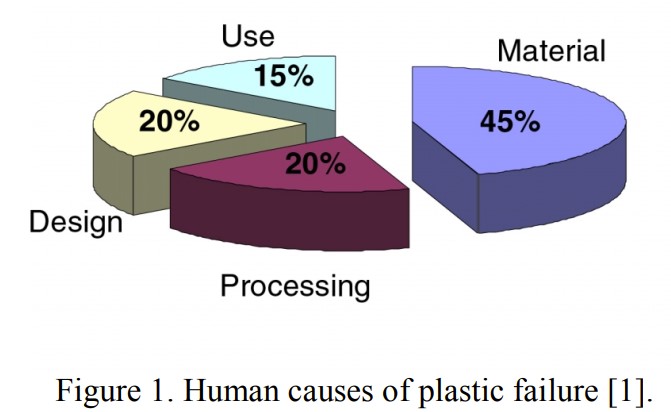This paper was originally published at the Society of Plastics Engineers TOPCON Conference 2005.
Abstract
Plastic materials can be divided into several classes, the most common being thermoset and thermoplastic. Within each of these groups, there are subgroups that further define plastic. For example, a thermoplastic is generally classified as being semicrystalline or amorphous depending on the level of crystallinity that exists. All these different groups of plastics have unique properties that give an engineer numerous options when choosing for an application. Unfortunately, one common property of all plastics is their vulnerability to fail under certain conditions. Fortunately, conditions for failure to occur are also unique to each class or subclass of plastic – failure of an amorphous thermoplastic may not result in failure of a thermoset under similar conditions. It is the understanding and knowledge of what conditions cause failure in each class of plastic that an engineer must know to properly specify a material. This paper will shed some light on some differences between these two classes of materials.
Background of Plastics
There is no doubt that the unique properties of plastic makes it one of the most sought after materials in the world today. Their low weight, ability to be easily shaped or molded, low cost, rigidity or flexibility, and the ability to insulate are only a few of the characteristics that make plastics a popular option when designing a new product or replacing an existing non-plastic one. Products such as home siding, electrical components, medical devices, piping, disposable packaging, automotive body panels and engine components are all products that have successfully been made from plastic.
Plastic has been in use for over a millennia. South American Indians used natural rubber in the manufacture of waterproof containers, shoes and torches. Thanks to the development of new plastics and processing equipment, application of plastic in every industry has exploded over the last 50 years. Nearly everyone can think of at least one product that was once made of metal or wood that is now plastic.
Similar to every other material, as long as there have been plastic materials, there have been failures. Because plastics have been limited in use at elevated and sustained load bearing applications, their exposure to high profile losses has been relatively small. However, as industry becomes more comfortable with plastic, further utilizing and pushing the boundaries of its unique properties and cost savings, exposure to more critical applications will certainly increase. This is never more evident than in the current race to develop the next generation of passenger aircraft. Utilization of plastics in this extremely high profile, as well as structurally demanding, industry is the ultimate key to their success.
Plastics are a unique material that can behave quite differently under varying conditions. The degree of change in behavior is again unique to each class of plastics. This is an obvious distinction between thermoset and thermoplastic materials. Many thermoplastics are ductile under one condition, and with a relatively small change in condition are brittle. A common example of this is seen with Silly Putty®. If one pulls this material slowly it can be stretched almost indefinitely (ductile). However, if one pulls quickly on this material it breaks (brittle). Decreasing the temperature of the Silly Putty®, decreases the stretching rate at which it becomes brittle. In essence, thermoplastics have important properties that are temperature and time (rate) dependent – a characteristic that is not seen with other materials. On the other hand, most properties of thermosets are more stable over normal conditions. If failure does occur, it will more than likely be in a brittle mode. Both scenarios have their advantage, and again, it is up to the engineer to understand what situation applies best for the application at hand. If the engineer does not take this into account, a plastic part may be able to absorb loads under one condition, but completely fail under another condition – two conditions that might possibly be relatively close to one another.

Contributors include: Paul Gramann, Antoine Rios and Bruce Davis
